
Japanese Daruma Dolls: The true story behind the insanely cute souvenirs!
- Written by: Lucio Maurizi
The Daruma is a traditional Japanese doll, which in Japan has become a symbol of perseverance and luck. But outside Japan, not many people know of its history, or what hides behind its goofy look.
Imagine you’re visiting Japan. You have a few more days before you have to travel back home, and your friends and family all asked you to bring souvenirs. You want to be original, maybe avoid the usual alcohol, keychains with pictures of famous landmarks, or the very popular (rightfully so) but a little cliché multi-flavors of KitKat. As you walk you see a cute, red, round doll in one of the shops’ windows. You stumbled upon one of the most iconic Japanese items you can find.
The Daruma is indeed one of the symbols of Japan. It makes sense to take home with you and give it as a present, or display it on a shelf, but its appearance might be deceiving, as this doll, representing a deity, has a long history, rich heritage, and a quite disturbing origin.
The Legend Behind the Daruma Doll

The Daruma is modeled after Bodhidharma, a monk accredited with the founding of Zen Buddhism, who seems to have lived between the 5th and 6th centuries CE. His origins are shrouded in mystery, and most of the accounts documenting his life are mixed with legends, making the tracking of Bodhidharma’s pilgrimage from the “Western Regions” (possibly central Asia) a very hard task.
During his travels he stopped for a time in a Shaolin monastery in China, founding the famous homonymous martial art. He then continued his journey until he decided to settle in a cave and meditate. This is where the history of the Daruma (after Bodhidharma’s Japanese name) begins.
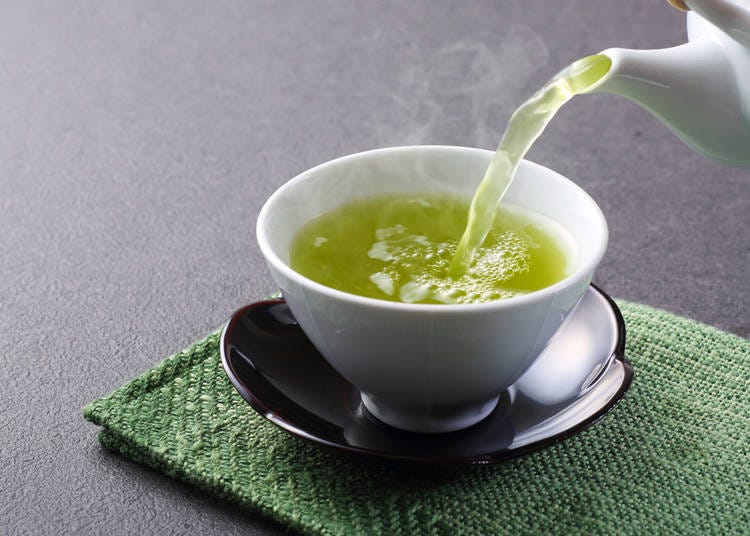
The monk became a wall-gazer. He meditated, eyes to a wall, in a seated position for nine years, without breaks, and without closing his eyes, except once, after seven years. He was so furious at himself for what he perceived as lack of discipline, that he sliced his own eyelids off so to prevent himself from ever sleeping again. As the eyelids touched the ground, they sprouted green tea plants. This legend is one of the reasons behind Buddhist monks often drinking green tea to stay awake.
On top of self-mutilation, Bodhidharma also suffered the loss of his arms and legs (according to some legends they fell off his body) as a consequence of his immobility for nine years. Art and folklore depicting Bodhidharma show him almost exclusively displaying these characteristics, which is why the Daruma dolls, in all its aspects, symbolize Bodhidharma’s position and features.
In addition, everything about the Daruma’s design has deep roots and meaning, down to the most minute details, making this doll much more than a simple household item.
Features of Daruma Dolls
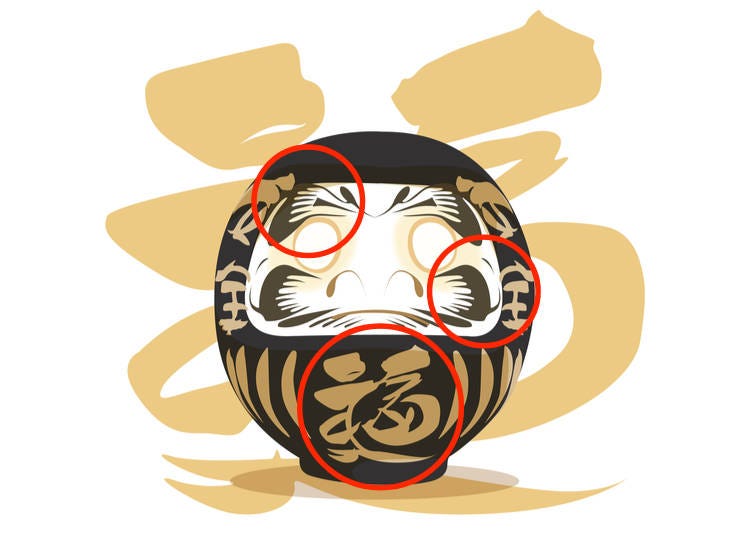
Daruma Doll Eyes: one of the most noticeable features of the Daruma is its blank glance. These dolls do not have pupils but they present large white circles where the eyes would be. One of the theories behind this choice in the design is linked to the legend of Bodhidharma removing his own eyelids.
A more prominent one suggests that it derives from the fact that, in the past, those who wanted the god residing in the doll to help them achieve their goals would vow that they would give Daruma its eyesight if the god helped them succeed in their endeavors.
Facial hair: The beard and eyebrows painted on the doll are meant to reproduce Bodhidharma’s facial features, but they do not serve a merely aesthetic purpose.
In fact the eyebrows are shaped to look like cranes, and the beard like turtles. These two animals often represent longevity, in Japanese culture (as well as in the rest of East Asia). Crafters started applying these shapes on the Daruma to match the Japanese proverb “The crane lives 1000 years, the turtle 10,000”.
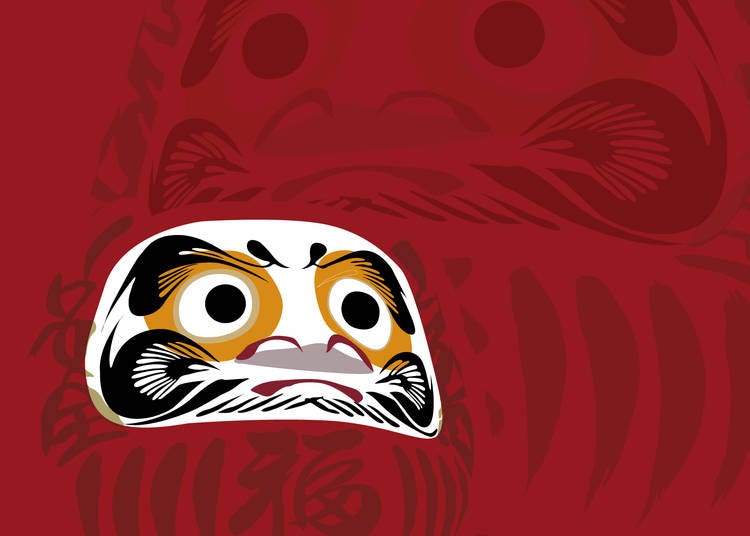
Body: the Daruma presents no legs or arms, as a reminder of Bodhidharma losing his limbs in his quest to reach enlightenment through self-sacrifice and meditation, but there is more.
The original dolls were designed to be impossible to tip over. Tilting them would always result in the Daruma swinging back into its upright position. The Daruma is a talisman of luck, but more importantly perseverance. One asking for the help of this god acknowledges the importance of sacrifice in the face of adversity.
For this reason the doll serves as a reminder than no matter how many times one could get knocked down, one must always endure and stand back up, in order to achieve a goal. Strongly connected to this ideology and to the Daruma itself is the Japanese expression nanakorobi yaoki, which loosely translates into “seven times down, eight times up”.
Writing: kanji meaning “luck”, “fortune”, “perseverance”, or similar others are sometimes written on the Daruma’s midsection, probably as a reflection of the reason for which the doll was acquired. Additionally, sometimes, people write their wish, or goal, on the doll itself, maybe to remind themselves, or to inform the god in a more “official” manner.
Color: the reasons behind the choice of the color of the Daruma are interesting, but convoluted, and hard to find consensus on. Nowadays we can find these dolls decorated in all sorts of colors, each one of them signifying a different auspice.
For example, in Japan, the color gold is linked to money and fame; black is meant to ward off bad luck; green symbolizes heath and fitness. Yet these color-theme associations are drawn from a myriad of different beliefs, superstitions, and legends, all of which come together to form a collective image.
One thing that is certain, though, is that to this day the most common color used for the Daruma is red, and originally it was the only color. For centuries scholars tried to grasp the motivation behind this color-choice, but even today it proves to be hard.
One of the reasons might connect to Bodhidharma, who, given his Buddhist background may have worn red robes. Similarly, monks today use robes of the same color.
Other theories refer to the supernatural powers of the color red and its connection to the gods. Adding to the already very grim legends surrounding the Daruma, its staple color may have originated from a period of devastating smallpox outbreaks across Asia.
In Japan, and elsewhere, not knowing how to fend off such a “curse” sent by a vengeful god, people started wearing red garments, thinking that this color pleased the god of smallpox and would have helped in repealing the illness. By the same token, people would decorate their doors and houses with red ropes, in an attempt to block the illness from accessing their homes.
Yet this theory would not explain why, very often, victims of smallpox would be wrapped while ill, and in death, with red drapes, as portrayed in the book Shipwreck by Akira Yoshimura. According to some research some people believed that the god of smallpox didn’t like the color red. He hated it so much, in fact, that people believed that he might transfer the curse with which he afflicted people, from the victim to the drape tinted in what for him was such an infuriating hue.
Throughout history Daruma dolls were believed to be able to ward off illness, and help with recovery (literally bouncing back to health), and great part of this ability was associated to the color red, but no one was ever able to give a universally accepted reason as to why.
How Daruma Changed Over Time
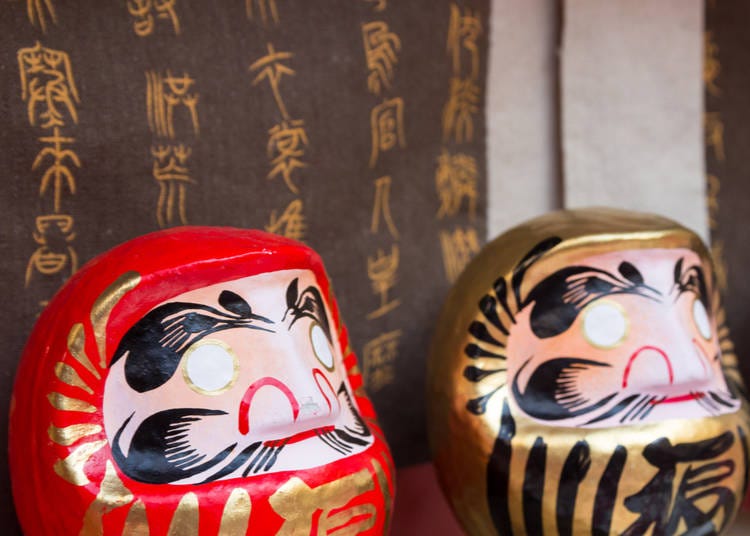
The history of the Daruma dates back to the 17th Century. It was local farmers in the city of Takasaki, in the Gunma prefecture, that crafted the first version of these dolls, as charms to be blessed by monks. Since the farmers’ livelihood depended heavily on luck, they devised this superstitious trick to help them in their harvest. In the span of a few decades the practice of using the Daruma spread across professions and regions.
As often tradition goes, the history and origin of the Daruma doesn’t carry the same weight it used to. Its colors are not the only thing that has changed. One of the biggest changes that occurred is that of its representation as female dolls, the so-called Princess Daruma, and Lady Daruma.
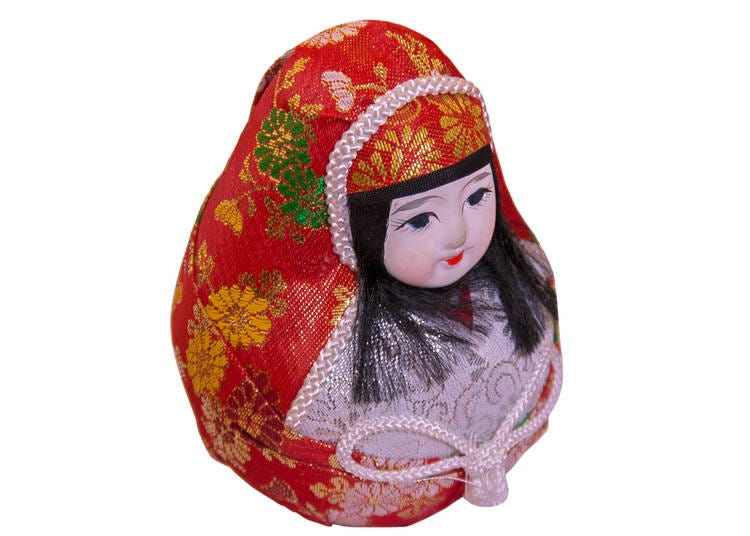
While these interpretations gave life to images such as Hello Kitty and Miffy as a Daruma, assuming that these changes happened in modern times would be wrong. In fact the first and most drastic spins on the image of the god happened during the Edo Period in Japan (1603-1868), shortly after the dolls were first introduced.
During that time, a very clear separation of social classes occurred. Merchants were often placed at the bottom of the ladder, which prompted them to create a sort of micro-society for themselves. Among many other things, they gave life to the female representations of the Daruma. This was probably intended to take jabs at the establishment, which always portrayed Bodhidharma as a masculine, strong figure. Paintings of Bodhidharma as a woman became more common, while more and more satirical associations to the god became every-day events.
The Daruma ability to stand up no matter how many times one would lay it down, was associated to prostitutes and their tendency to do the same. Phallic depictions of Daruma also became more commonplace until, in time, the original image and the satirical ones were almost on par with each other in number and use.
In modern and contemporary times the Daruma has become a souvenir, a display item, and a cute present. Yet it has not completely lost its original power in the collective imaginary. While it is not common to find people who know the full history behind this good-luck charm, the Daruma is often purchased to help achieve one’s goals.
How to Use a Daruma Doll
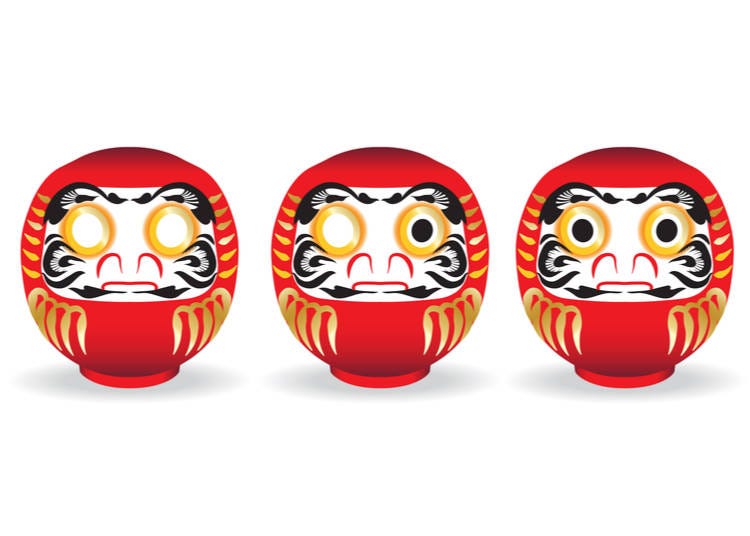
If the grim history and legends behind the Daruma have not yet scared you off, you might want to learn just how exactly to use this talisman, if you believe it could help you. Its appeal is that its “power” is a mix of supernatural and psychological.
As mentioned earlier, upon purchase, the doll is missing its eyes. What you do is paint one eye in one of the blank white circles while committing to your goal and asking for help to the god. You would then paint the second eye, giving the god its eyesight back as a thank you for helping you, once you achieve your goal.
You would need to remember that Daruma rewards sacrifice and unwavering force of will. Note that Bodhidharma was the one who refused to help another monk who wanted to become his apprentice until the young pupil decided to demonstrate his determination by cutting off his own arms.
One year after purchasing the Daruma you should return it to the temple from where you obtained it and burn it, regardless of whether you succeeded in what you wished for. There is even a ceremony called daruma kuyo or dondoyaki in several temples across Japan, during which huge piles of Daruma are burnt at the same time (but these are not the only occasions during which you can burn your Daruma doll).

Originally, the beneficial effect of the doll was believed to expire after one year. After this span of time, the doll needed to be burned in order to free the god. This process is not meant to be interpreted as giving up on one’s goals. On the contrary, it’s imagined as a renewal of one’s vow (and a commitment to buy another Daruma).
Making a Daruma Doll
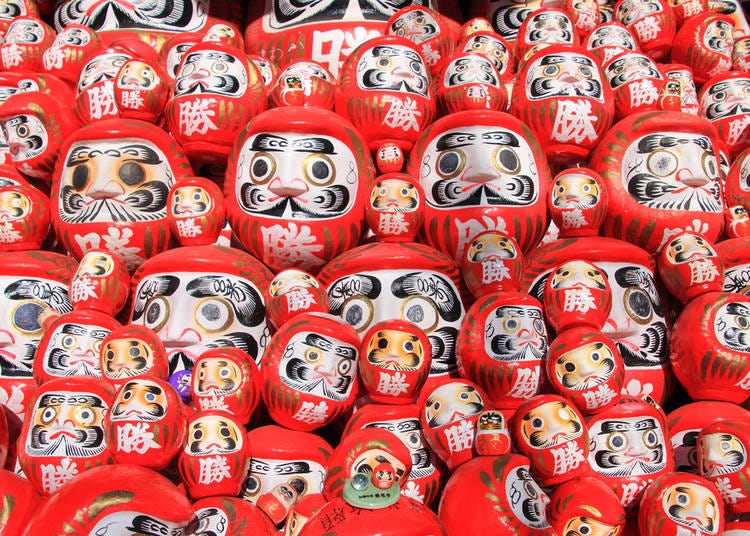
The production of Daruma dolls is an almost exclusive enterprise of the city of Takasaki, in Gunma Prefecture (north of Tokyo). The town produces over 80% of all the dolls distributed in Japan. From here, the dolls reach every corner of the country, and can be purchased in every city (or online through many websites – including Amazon).
The Daruma are crafted with a special kind of hand-made papier-mâché called washi.
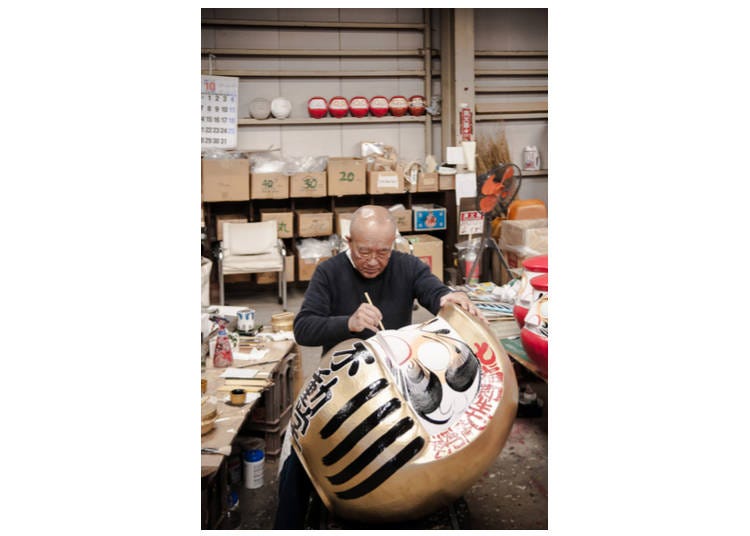
The making of washi is very labor-intensive and is considered, in Japan, an art of its own. The sheets are extremely resilient and are crafted from fiber, vats, and a limited amount of chemicals, through a process of beating (often by hand) and drying in the sun, or on heated plates.
All Daruma are handmade and hand-painted, so no two dolls have the exact same design.
Daruma in Modern Japanese Culture
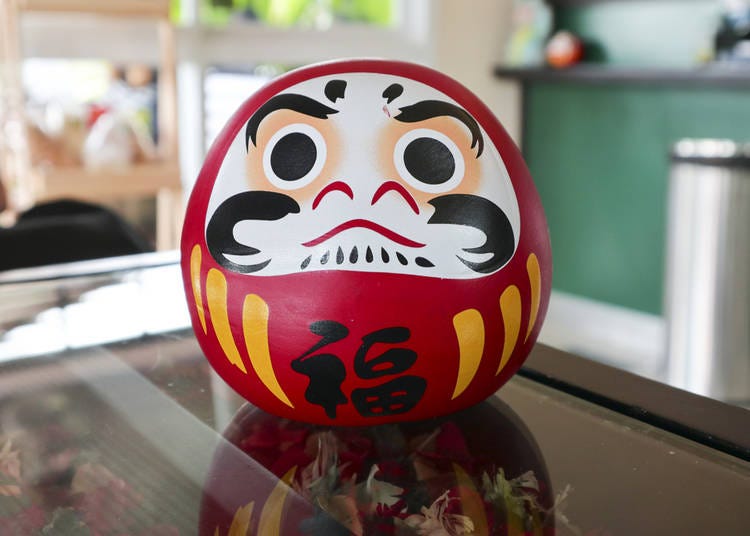
Very much like among farmers (and later all kinds of businesses) in the past, it is not uncommon, even today, to see a Daruma doll decorating a restaurant, or a store, or a home. Its size could also give an idea of the magnitude of one’s wish, since its believed that the larger the doll, the bigger the aspiration of the person who acquired it.
The use of Daruma, though, is not limited to business, or a few private households. This doll has gained, across centuries, such a privileged place in Japanese culture, that it tends to appear in a number of situations and venues.
Politicians, for example, often carry with them their own dolls during interviews, speeches, and addresses, particularly during the election period. Like everyone else who obtains a Daruma, they have a wish, and pledge to repay the god with eyesight should he grant it to them. Arguably, this also dips into a cultural belief in Japan, through which a politician may be showing his determination and commitment to the country and its people through the symbolism embedded with the Daruma.
This familiar Japanese staple item certainly underwent numerous changes and interpretations. It’s regarded as a god who may help achieving success. It represents one of the most important aspects of Zen Buddhism with its relation to patience, perseverance, and sacrifice. It became a figure to which one asks for help through threats (giving the god his sight back only if he helps us). In its history the Daruma was both a symbol of the ruling class, and a tool used to mock and challenge the establishment.
While Japan possesses a very interesting culture and is vastly rich of symbolism and traditions, few others of the country’s images can boast an equally multifaceted and mysterious origin and meaning so deeply rooted into society.
Common Questions About Daruma Dolls
Over time, readers have asked us questions about daruma. We've checked our answers with knowledgeable Japanese and compiled them here.
1. I have read that a person can keep their daruma doll forever - though one year is more common. Is this true?
A daruma doll is typically kept until an objective has been achieved. Many Japanese will consider a goal that is achievable within one year, hence this is very common. However, as painting the eye is representing your commitment to a goal, it's more about that achievement than anything else.
2. I have a daruma doll and would like to reset the eyes to be white so I can reuse it again. Is this is allowed? Can you recycle a daruma doll?
Strictly speaking, a daruma doll is about your own achievement and most Japanese would likely not consider "resetting" or "recycling" one. If a daruma doll has brought you good luck toward your achievement, fantastic! As possible, let someone else experience the same feeling with their own, new daruma doll.
According to our Japanese correspondents, "recycling" a daruma doll would not bring bad luck to a recipient, but as it is a personalized object, it should belong to one person. The analogy in Western culture might be akin to going to a wishing well, removing a coin someone else had tossed, wishing on it, and tossing it back in.
3. Can I buy a daruma doll for someone else?
Many Japanese would typically purchase a daruma doll for their own use, however, buying one as a gift for someone else is fine as well. Incidentally, just as there is no deadline placed on achieving a personal goal, there is no set deadline for the recipient to set his or her goal using the daruma.
4. Can I make a wish for someone else using a daruma doll?
As a daruma doll is intended for a wish about something achievable for you, it would typically not be used for a hopeful outcome for someone else. That said, close family members may use a daruma as a kind of omamori amulet and, for example, wish for a good score on a school entrance exam or similar.
Lucio Maurizi is an automotive expert specializing in Japan's car scene and auto-tourism. With an MA in East Asian History from La Sapienza Università di Roma, he's a multi-talented contributor to travel platforms like LIVE JAPAN, Japan Travel, and GPlus Media. His Instagram account (50k+ followers) offers insider views on Japan's automotive culture. Lucio also actively collaborates with professional drivers and influencers and organizes can't-miss car events in Tokyo.
*Prices and options mentioned are subject to change.
*Unless stated otherwise, all prices include tax.
Recommended places for you
-
Goods

Yoshida Gennojo-Roho Kyoto Buddhist Altars
Gift Shops
Nijo Castle, Kyoto Imperial Palace
-
Menu

ISHIDAYA Hanare
Yakiniku
Kobe, Sannomiya, Kitano
-

Kamesushi Sohonten
Sushi
Umeda, Osaka Station, Kitashinchi
-

Tokyo Metropolitan Government
Landmarks
Shinjuku
-
Appealing

Rukku and Uohei
Izakaya
Sapporo / Chitose
-

Jukuseiniku-to Namamottsuarera Nikubaru Italian Nikutaria Sannomiya
Izakaya
Kobe, Sannomiya, Kitano
-

Experience the Magic of 'The Nutcracker' in Tokyo This Winter
-

Mister Donut x Pokémon 2024: Catch Limited-Edition Donuts and Fun Collectibles!
-

Celebrate 25 Years of Nikko's UNESCO Sites: 2 Limited-Time Plans to Explore Buddhism and the Samurai Spirit
-

2024 Ranking of Top-Rated Onsen Ryokan with Exceptional Baths—Must-Visit Hot Springs in Japan!
by: Nemi Lin
-

The Ride of Your Life! Experiencing Japan from Above in a Private Helicopter Tour
by: Cassandra Lord
-

Explore Autumn in Hyogo Prefecture: Two-Day Road Trip to See Stunning Foliage and Top Attractions
by: Hide
-

31 Fun Things to Do in Sapporo Hokkaido - Places to Go, Local Food & Sightseeing Tips
by: Andy Cheng
-

Iizaka Onsen Guide: Japan's Gorgeous Hidden Hot Springs Town! (Access, Things to Do, Ryokan)
-

Kaminoyama Onsen Guide: Best Things to Do in Japan's Samurai Town!
-

Hokkaido Lavender Fields: 6 Best Places in Furano to See Japan's Dreamiest Purple Meadows
by: Nobuka Kawashima
-

Hakodate 2-Day Itinerary for Exploring Japan's Foodie North!
-

6 Fun Things to Do at Tokyo's World-Famous Tsukiji Outer Market!
- #best sushi japan
- #what to do in odaiba
- #what to bring to japan
- #new years in tokyo
- #best ramen japan
- #what to buy in ameyoko
- #japanese nail trends
- #things to do japan
- #onsen tattoo friendly tokyo
- #daiso
- #best coffee japan
- #best japanese soft drinks
- #best yakiniku japan
- #japanese fashion culture
- #japanese convenience store snacks















